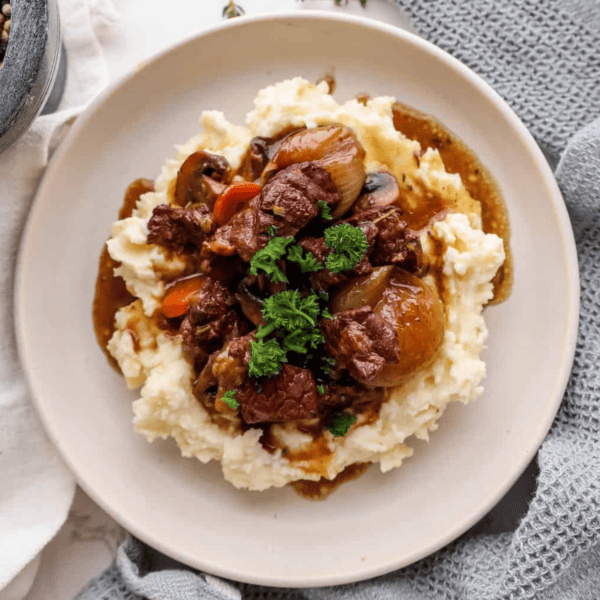This post contains affiliate links. Please read our disclosure policy.
The Best Easy Skillet Lasagna takes the long wait time and all the prep work out of lasagna so you can have the cheesy, creamy, delicious flavor in under an hour!
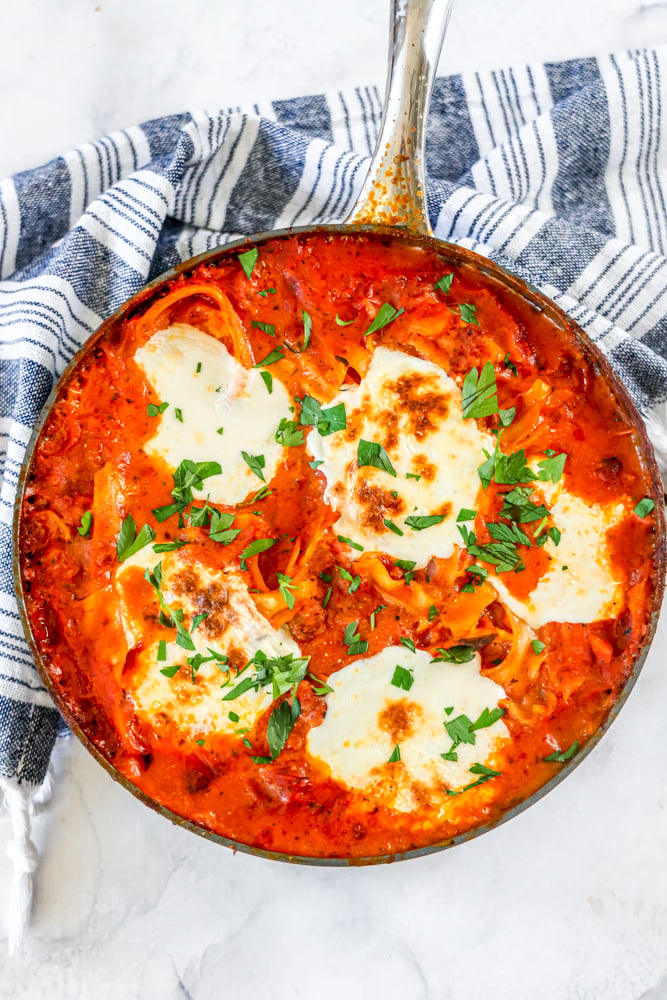
Don’t want all the extras in a recipe post? We provide a skip to recipe button in the top left corner, as well as a clickable table of contents, just below, to help make this page easier to navigate.
At Sweet C’s, I add lots of tips in all of my recipes – so you can make this dish, understand why it works, and what each ingredient means to the flavor of a recipe – so even the most beginner home cook can become an expert and feel empowered in the kitchen. I want each reader to walk away with a solid knowledge of each recipe, with all of the tips I’ve gathered from extensive testing of each recipe. I also answer questions my friends and family have asked about my recipes, to help home cooks of any skill level better understand the processes we use and why!
Table of Contents
Hearty Skillet Lasagna
If you’ve ever been craving delicious, cheesy, hearty lasagna – but looked at the clock and said there is just no way – this recipe is for you.
Lasagna can take forever – pre-boil noodles, make the sauce, assemble the layers, and then bake – but this super simple skillet lasagna can be made in just one pot in under an hour!
Making lasagna in a skillet makes it super easy to get tons of flavor quickly – this dinner is a huge family favorite, and one I don’t mind whipping up.
Follow our steps below to make sure this is the best lasagna skillet ever – including our filling ideas, recommendations for cheese and sauce, and tips to make it perfect!
For more delicious lasagna ideas, be sure to check out my Cottage Cheese Lasagna Recipe – using cottage cheese instead of ricotta cheese; or my easy eggplant lasagna for a low carb cheesy twist!
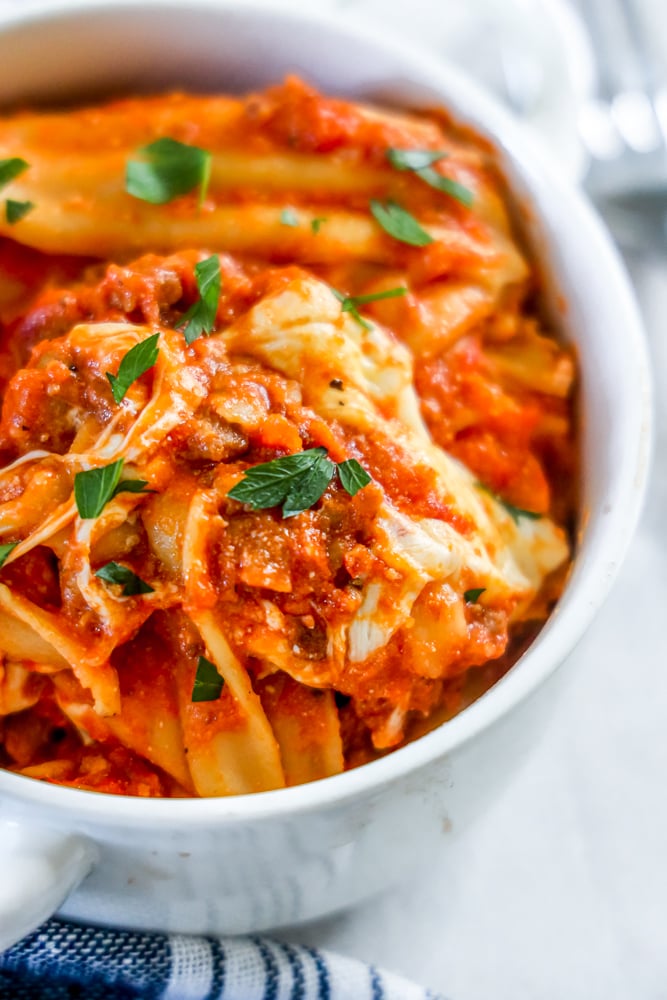
How to Make Skillet Lasagna
First assemble the following ingredients:
- Sweet Italian Sausage (1 pound) – Sweet Italian sausage adds a rich, savory depth with a hint of sweetness and spice, serving as the hearty base for the skillet lasagna.
- Onion (1) – Chopped onion provides a foundational aromatic flavor, softening and sweetening as it cooks to enhance the overall dish.
- Cloves garlic (3-6) – Minced garlic infuses the lasagna with its pungent and earthy notes, crucial for building the classic Italian flavor profile.
- Italian herbs seasoning blend (2 tsp) – Italian herb seasoning, a blend of dried herbs like oregano, thyme, and basil, brings a fragrant and herby complexity to the sauce.
- Celtic sea salt (1 tsp) – Celtic sea salt enhances the flavors of the other ingredients, adding depth and highlighting the natural tastes of the lasagna components.
- Cracked pepper (1 tsp) – Freshly cracked pepper adds a subtle heat and piquancy, balancing the richness of the cheeses and sausage.
- Pasta sauce (24 ounces) – A robust pasta sauce acts as the moistening agent, enveloping the noodles and fillings in a tangy, tomato-based embrace.
- Water (1 1/2 cups) – A splash of water is essential to ensure the no-boil noodles become perfectly tender, absorbing the liquid as they cook within the skillet.
- Uncooked lasagna noodles (8) – Uncooked no-boil lasagna noodles provide the classic structure and texture, conveniently softening as they simmer in the sauce.
- Ricotta cheese (3/4 cup) – Ricotta cheese contributes a creamy, rich layer, adding a light and slightly sweet dimension that contrasts with the savory elements.
- Mozzarella cheese (8 ounces) – Shredded mozzarella cheese melts into stretchy, gooey layers, binding the ingredients together with its mild and milky flavor.
- Parmesan cheese (1/4 cup) – Grated Parmesan cheese offers a nutty, salty finish that enhances the overall taste and provides a golden crust when sprinkled on top.
- Parsley – Fresh parsley adds a burst of color and a clean, slightly peppery taste, garnishing the dish with a touch of freshness.
Use this Method
Cook Meat. Brown sausage in a large nonstick pan that has a lid, using a spatula to crumble sausage at it browns. When sausage has browned, remove from pan and set aside. Do not drain fat from pan.
Cook Veg. Add onion and cook 3 minutes, stirring occasionally, until lightly browned and softened. Add in garlic and cook 1 minute until soft and fragrant. Place sausage back in pan, stir to mix well.
Combine. Break lasagna noodles into pieces and add to pan. Dump in sauce, water, herbs, and noodles and stir to mix well. Bring to a boil, then reduce heat to low. Stir in ricotta cheese and shredded mozzarella cheese and half of the parmesan.
Cook. Cover pan with a lid and cook for 15 minutes, or until your noodles are al dente – with just a little bite left. Stir often to prevent burning. Top with rest of parmesan and thin mozzarella slices and let melt.
Garnish and Finish. When cheese is melted, remove from heat, and serve. Garnish with parsley and grated parmesan cheese, optional.
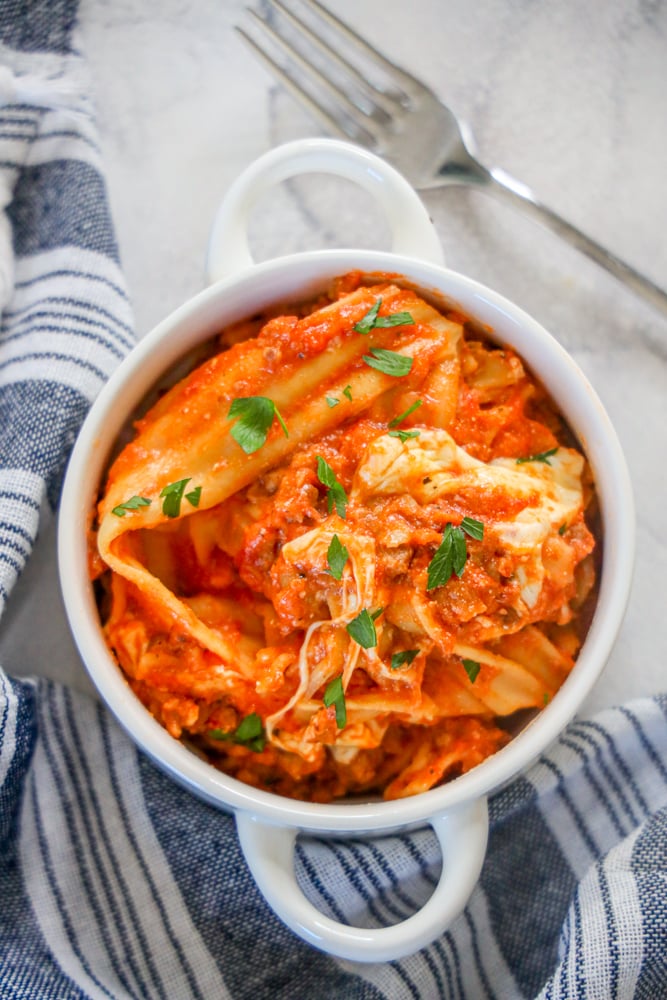
Tips and Tricks To Perfect Skillet Lasagna
Use No-Boil Noodles: Opt for no-boil lasagna noodles to save time and effort. They cook directly in the sauce and absorb more flavor as they soften.
Choose the Right Skillet: Use a large, deep skillet with a lid to accommodate the layers and allow for even cooking. Cast iron or a heavy-bottomed non-stick skillet works well.
Layer Carefully: Start with a thin layer of sauce at the bottom to prevent the noodles from sticking, then layer noodles, cheese, and fillings, ending with a generous layer of cheese on top.
Break Noodles to Fit: Don’t be afraid to break the noodles to fit your skillet shape. This won’t affect the final dish’s taste or texture.
Simmer Gently: Keep the heat on low to medium-low to allow the lasagna to simmer gently, preventing the bottom from burning while ensuring the noodles cook through.
Cover the Skillet: Covering the skillet helps trap steam, which is essential for cooking the noodles and melting the cheese. If your skillet doesn’t have a lid, you can use aluminum foil.
Use Enough Sauce: Be generous with the sauce, as no-boil noodles absorb a lot of moisture. This helps ensure they cook properly and the lasagna doesn’t turn out dry.
Add Water if Needed: If the sauce thickens too much during cooking, don’t hesitate to add a little water around the edges to help the noodles cook evenly.
Let It Rest: After cooking, let the lasagna rest for about 10 minutes before serving. This allows it to set, making it easier to cut and serve.
Incorporate Fresh Herbs: Add fresh basil or oregano towards the end of cooking or as a garnish to enhance the flavors and add a burst of color.
Experiment with Fillings: Feel free to experiment with different fillings like spinach, mushrooms, zucchini, or different cheeses (ricotta, mozzarella, parmesan) to customize your lasagna.
Use Quality Ingredients: Since skillet lasagna has fewer layers than traditional lasagna, each ingredient shines through, so use high-quality cheese, sauce, and fillings for the best flavor.
Cheese on Every Layer: Ensure there’s cheese on every layer, not just the top, to achieve a gooey, melty texture throughout the lasagna.
FAQS
No, you don’t need to pre-cook the noodles if you’re using no-boil lasagna noodles. They will cook directly in the sauce as the lasagna simmers.
Yes, but it’s recommended to pre-cook regular lasagna noodles until they are al dente before adding them to the skillet to ensure they become fully tender during the cooking process.
A large, deep skillet is best, preferably non-stick or cast iron with a lid. The depth is important to accommodate the layers, and a lid helps trap steam to cook the noodles.
Absolutely! You can easily make a vegetarian skillet lasagna by substituting the meat with vegetables like spinach, mushrooms, zucchini, or eggplant, or simply by using more cheese and sauce.
Start with a generous layer of sauce at the bottom and maintain a low to medium-low heat during simmering. Stirring gently around the edges occasionally can also help.
The lasagna is done when the noodles are tender, the cheese is melted and bubbly, and the sauce has thickened. This typically takes about 20-25 minutes on the stove top.
Yes, but keep in mind the size and depth of your skillet. Too many layers might not cook evenly or might overflow during cooking. Three to four layers are usually manageable and effective.
Allow the lasagna to cool, then cover the skillet with a lid or aluminum foil, or transfer leftovers to an airtight container and refrigerate for up to 3-4 days.
Yes, you can freeze skillet lasagna. Cool it completely, slice it into portions, and then wrap each portion tightly in plastic wrap followed by foil. It can be frozen for up to 3 months.
Reheat leftovers in a microwave-safe dish in the microwave or covered with foil in an oven preheated to 350°F (175°C) until heated through, about 20-30 minutes.
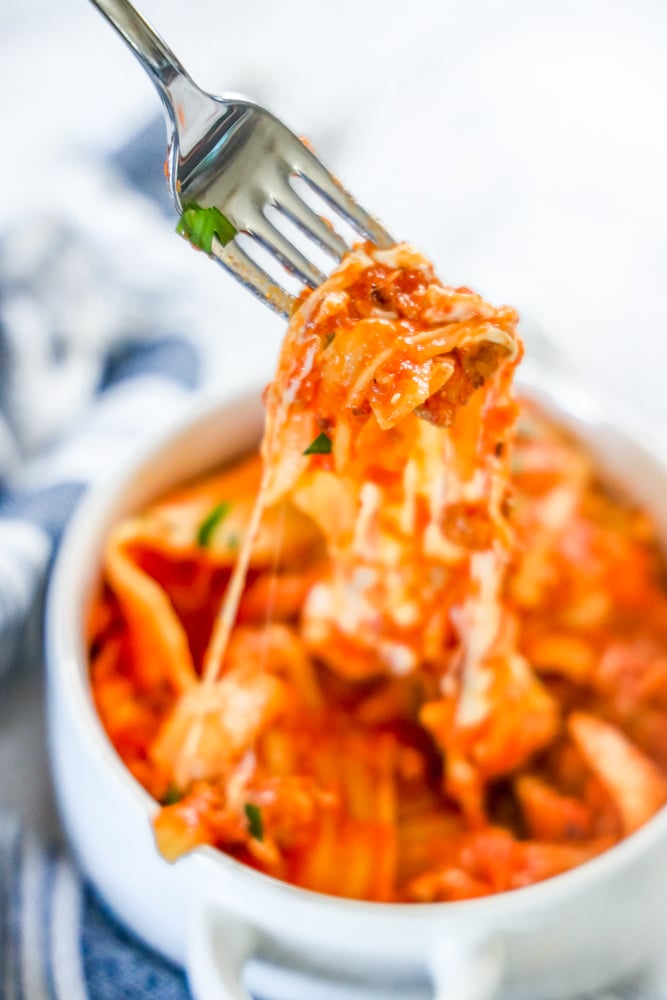
What to Serve With Skillet Lasagna
This lasagna is rich, hearty, and really filling on it’s own – but it pairs well with lots of simple vegetables, a nice salad, or even some easy fresh baked bread. I love to serve my 10 minute broccolini, a delicious Greek farm salad, or my to-die-for no knead bread alongside skillet lasagna. Also try these combinations:
Garlic Bread: The crispiness of toasted garlic bread contrasts beautifully with the soft, saucy texture of the lasagna, and it’s perfect for mopping up any leftover sauce on your plate.
Caesar Salad: A fresh Caesar salad with crisp romaine, creamy dressing, and crunchy croutons offers a refreshing counterpoint to the rich and cheesy lasagna, balancing the meal.
Steamed Broccoli or Green Beans: Lightly steamed vegetables like broccoli or green beans add a healthy, crunchy element to the meal and provide a subtle bitterness that complements the tomato sauce’s acidity.
Roasted Vegetables: Roasted vegetables like zucchini, bell peppers, and eggplant bring out a natural sweetness and a charred flavor that pairs well with the savory layers of the lasagna.
Caprese Salad: Fresh tomatoes, mozzarella, and basil in a Caprese salad echo some of the key flavors in the lasagna, while offering a lighter, more refreshing taste experience.
Antipasto Platter: An antipasto platter with a selection of olives, artichokes, cured meats (for non-vegans/vegetarians), and cheeses adds variety and allows diners to customize each bite.
Sautéed Spinach or Swiss Chard: Leafy greens sautéed with garlic and a splash of lemon juice provide a simple and nutritious side that cuts through the richness of the lasagna with its bright acidity and slight bitterness.
Ratatouille: A side of ratatouille, with its stewed Mediterranean vegetables, complements the Italian flavors of the lasagna and adds a rustic, home-cooked feel to the meal.
Italian Bread with Olive Oil and Balsamic Vinegar: A crusty Italian bread served with olive oil and balsamic vinegar for dipping is a lighter alternative to garlic bread, but still offers a satisfying crunch and flavor contrast.
Red Wine: A glass of red wine, such as Chianti or Sangiovese, pairs wonderfully with skillet lasagna, as the acidity and tannins in the wine can cut through the richness of the cheese and meat.
Tiramisu or Gelato: For dessert, the lightness and sweetness of tiramisu or gelato offer a delightful contrast to the hearty main dish, providing a refreshing and satisfying end to the meal.
Try these other one pot meals:

If you love this easy recipe please click the stars below to give it a five star rating and leave a comment! Pease also help me share on Instagram, Facebook, and Pinterest!
Follow on Instagram

CONNECT WITH SWEET C’S!
Be sure to follow me on social media and get in on all the fun!
Only have 30 minutes to get dinner on the table? Sign up for my 30 minute dinner plans direct to your inbox!
Find and shop my favorite products in my Amazon storefront here!
Easy Skillet Lasagna

Equipment
- s.a.l.t. sisters Tuscan Farmhouse Italian Herb Blend – Dried Herb & Salt Seasoning for True Taste of Italy – Versatile Enhances Flavor of Tomatoes, Chicken, Pork, Beef, Fish, Popcorn, Pizza (5 Ounces)
Ingredients
- 1 pound sweet Italian Sausage
- 1 large onion, diced finely
- 3-6 cloves garlic, minced (I like a lot of garlic, adjust to your tastes)
- 2 tsp Italian herbs seasoning blend
- 1 tsp celtic sea salt
- 1 tsp fresh cracked pepper
- 24 ounces pasta sauce, your favorite brand
- 1 ½ cups water
- 8 uncooked lasagna noodles, broken into pieces
- ¾ cup ricotta cheese
- 4 ounces shredded mozzarella cheese
- 3 oz thinly sliced fresh mozzarella cheese
- ¼ cup grated Parmesan cheese
- parsley, to garnish – optional
Instructions
- Brown sausage in a large nonstick pan that has a lid, using a spatula to crumble sausage at it browns.
- When sausage has browned, remove from pan and set aside. Do not drain fat from pan.
- Add onion and cook 3 minutes, stirring occasionally, until lightly browned and softened.
- Add in garlic and cook 1 minute until soft and fragrant.
- Place sausage back in pan, stir to mix well.
- Break lasagna noodles into pieces and add to pan.
- Dump in sauce, water, herbs, and noodles and stir to mix well.
- Bring to a boil, then reduce heat to low.
- Stir in ricotta cheese and shredded mozzarella cheese and half of the parmesan.
- Cover pan with a lid and cook for 15 minutes, or until your noodles are al dente – with just a little bite left. Stir often to prevent burning.
- Top with rest of parmesan and thin mozzarella slices and let melt.
- When cheese is melted, remove from heat, and serve.
- Garnish with parsley and grated parmesan cheese, optional.
Nutrition
Nutrition information is automatically calculated, so should only be used as an approximation.



